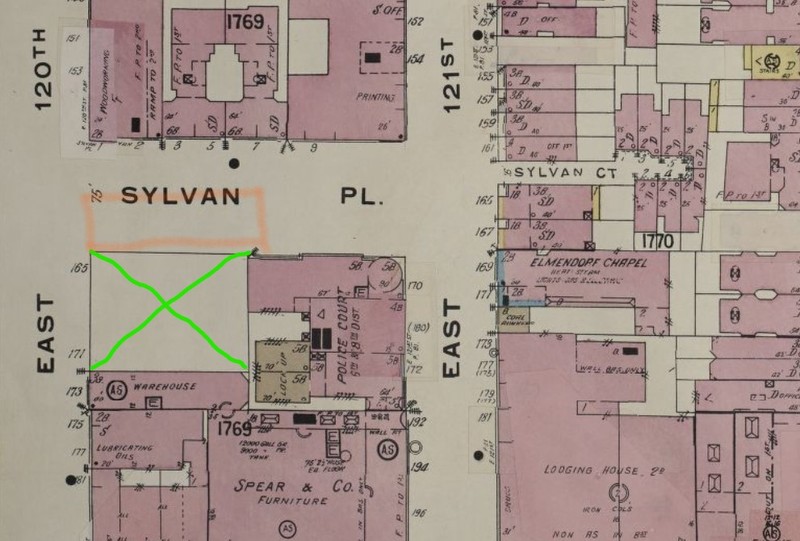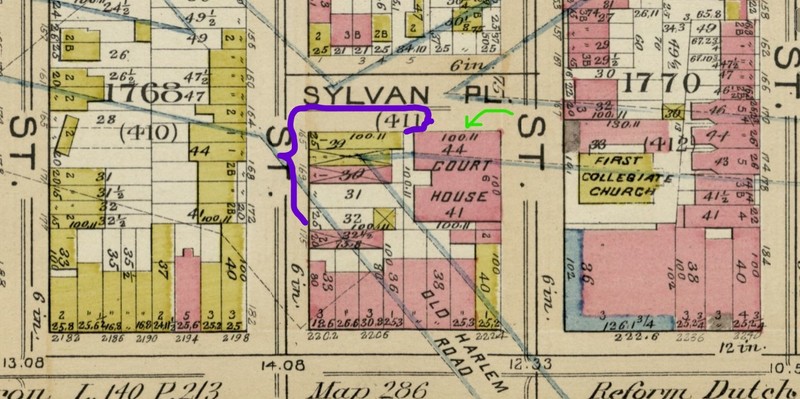Harlem Art Park
Introduction
Text-to-speech Audio
The plaza with benches behind the iron fence on the north side of E. 120th Street, halfway between Lexington and Third Avenues, is a New York City Park called Harlem Art Park. The eastern portion of the park, directly south of the Harlem Courthouse, used to be used as a recreational area by those housed in the temporary jail cells in the courthouse; the City of New York acquired the land in 1929 and intended to create a public bath but didn't. The city's Parks Department acquired jurisdiction over this part of the park in 1945. The former road to the west of the courthouse and the park, Sylvan Place, was closed in the 1980s; half of the Sylvan Place footprint was added to the park in 1992.
Images
Harlem Art Park tracts (green and orange) on 1951 Sanborn map; N to right (V. 8 pt. 2 p. 81)


Backstory and Context
Text-to-speech Audio
The space that now contains the Harlem Art Park once served as a recreational yard for prisoners temporarily jailed at the Harlem Courthouse, directly north of the park. The jail cells have not been in use since 1940 due to environmental conditions, and most of the court-related functions in the building (except Small Claims Court) ended in 1961 (see the Clio entry for Harlem Courthouse).
After the City of New York acquired the eastern portion of the park, east of Sylvan Place, in 1929, the plans for creating a public bath ran into opposition. The 0.174-acre tract was vacant for nine years and began being used informally as an outdoor sitting place by 1938. The land did not formally become a city park until 1945.
Sylvan Place was closed to vehicular traffic in the 1980s and became part of a park for the use of the neighboring senior citizen housing, the Casabe Houses. On October 30, 1992, the eastern half of Sylvan Place was transferred to the City of New York's Department of Parks and was incorporated into the Harlem Art Park. Casabe House shares maintenance responsibilities for the park with New York City Parks. The park now holds 0.35 acres and functions as a neighborhood park.
The first piece of sculpture commissioned for a New York City Park in their Percent for Art Program was installed in 1985 at Harlem Art Park. The work, called "Growth," is by Jorge Luis Rodriguez and was restored in 2010 under the watchful eye of the original artist (see the video link below). The red metal sculpture is painted steel and 15 feet tall. Mr. Rodriguez was inspired by his Caribbean roots and views the work as either a seed sprouting from the ground, an insect changing into a flower, or a bird becoming a tree. Mayor Edward Koch's administration set up the program, in which one percent of the citywide construction budget is set aside for commissioning works of art for new construction projects. The City Department of Cultural Affairs administers the program; summer interns work on the Citywide Monuments Conservation Program.
Cite This Entry
Paonessa, Laurie. "Harlem Art Park." Clio: Your Guide to History. December 8, 2021. Accessed March 29, 2025. https://theclio.com/entry/142143
Sources
Afinelyne. 'Present Histories' Continue to Grow in Harlem Art Park, Gothem to Go: Art and Culture. August 10th 2018. Accessed December 8th 2021. https://gothamtogo.com/present-histories-arrives-in-the-harlem-art-park/.
Afinelyne. Celebrating the 35th Anniversary of the First Percent for Art Installation ... in Harlem Art Park, July 5, 2020, Gothem to Go: Art and Culture. May 26th 2020. Accessed December 8th 2021.https://gothamtogo.com/celebrating-the-35th-anniversary-of-the-first-percent-for-art-installation-growth-and-artist-jorge-luis-rodriguez-in-harlem-art-park-june-26-2020/
NYC Government. Harlem Art Park, New York City Parks. Accessed December 8th 2021. https://www.nycgovparks.org/parks/harlem-art-park.
NYC Government. Harlem Art Park, East Harlem Art Park, New York City Parks. Accessed December 8th 2021. https://www.nycgovparks.org/parks/harlem-art-park/history.
NYC Government. Harlem Art Park, Growth, New York City Parks. Accessed December 8th 2021.https://www.nycgovparks.org/parks/harlem-art-park/monuments
Library of Congress (LOC): https://www.loc.gov/item/sanborn06116_081/
LOC: https://www.loc.gov/item/2010587355/

